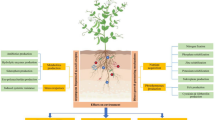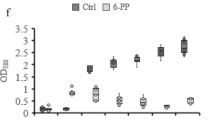Abstract
IN the course of work in progress on soil inhibitory factors, it has been observed that the spores of certain fungi which are unable to germinate when introduced into fresh fertile soil on glass slides coated with 0.5 per cent peptone in 2.0 per cent agar, owing to the presence in the soil of a fungistatic factor, may germinate readily when seedling roots grow in their immediate vicinity, that is, within a distance of some 2 mm. This observation has been made with conidia of Gliocladium roseum and Paecilomyces marquandii on glass slides buried beneath germinating peas so that the seedling roots grew into contact with the slides; and also with Fusarium solani and two unidentified isolates of Fusarium in similar experiments using seedlings of pea, wheat and lettuce. Fusarium solani and one of the unidentified Fusaria show peculiar behaviour; in the presence of soil their conidia germinate normally, but usually produce terminal chlamydospores on short germ tubes and cease further development. Park1 has reported similar formation of chlamydospores by Fusarium roseum in response to an inhibitory factor produced by Bacillus macerans. In the presence of seedling roots the chlamydospores germinate and growth is resumed (Fig. 1). According to the abstract of a thesis by Burke2 on root rot of Phaseolus vulgaris, Fusarium solani f. phaseoli may exhibit the same type of behaviour in naturally infested root-rot soils. It has further been observed with Gliocladium roseum and with the Fusaria studied that the germ tubes show a strong tropic growth towards the roots, although those of Paecilomyces marquandii do not appear to show such directed growth.
This is a preview of subscription content, access via your institution
Access options
Subscribe to this journal
Receive 51 print issues and online access
$199.00 per year
only $3.90 per issue
Buy this article
- Purchase on Springer Link
- Instant access to full article PDF
Prices may be subject to local taxes which are calculated during checkout
Similar content being viewed by others
References
Park, D., Trans. Brit. Mycol. Soc., 39, 239 (1956).
Burke, D. W., Diss. Abstr., 15, 12, 2390 (1955).
Rovira, A. D., Plant and Soil, 7, 178 (1956).
Dobbs, C. G., and Hinson, W. H., Nature, 172, 197 (1953).
Author information
Authors and Affiliations
Rights and permissions
About this article
Cite this article
JACKSON, R. Fungistasis as a Factor in the Rhizosphere Phenomenon. Nature 180, 96–97 (1957). https://doi.org/10.1038/180096a0
Issue Date:
DOI: https://doi.org/10.1038/180096a0
This article is cited by
-
Exudate molecules initiating fungal responses to seeds and roots
Plant and Soil (1990)
-
Effect of volatile substances released fromOriganum majorana andOcimum basilicum on the rhizosphere and phyllosphere fungi ofPhaseolus vulgaris
Folia Microbiologica (1978)
-
The effect of volatile and gaseous metabolites of swelling seeds on germination of fungal spores
Folia Microbiologica (1975)
-
Biological control of cotton wilt
Proceedings / Indian Academy of Sciences (1971)
-
Survival of microbial plant pathogens in soil
The Botanical Review (1963)
Comments
By submitting a comment you agree to abide by our Terms and Community Guidelines. If you find something abusive or that does not comply with our terms or guidelines please flag it as inappropriate.



